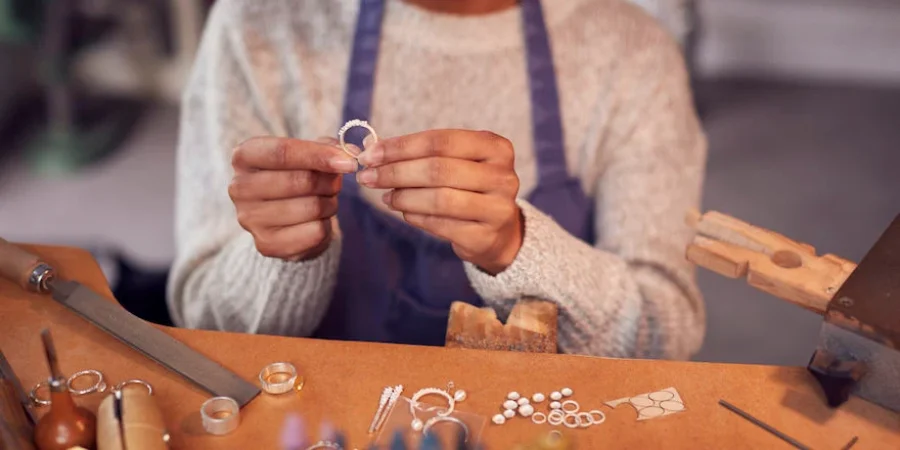The jewelry market has undergone a fundamental digital transformation, presenting unprecedented opportunities for independent designers. Establishing an online presence is no longer optional but essential for growth in this evolving market.
Why Online Sales Are Crucial Today
The online jewelry market is experiencing rapid growth, with a 10% annual increase, and over 60% of buyers now prefer online purchases due to variety, convenience, and price transparency. This shift signals an irreversible change in market dynamics, making a digital presence crucial for jewelry designers to compete and reach new customer segments. E-commerce offers flexibility and global reach, enabling independent artists to thrive. The market for personalized and custom-made jewelry is growing, particularly among younger consumers aged 25 to 44, who seek unique and meaningful pieces. This preference gives independent designers a competitive advantage over mass-produced goods. By focusing on custom services, authentic storytelling, and ethical sourcing, designers can enhance their products, build emotional connections, command higher prices, and cultivate loyal customer bases.
A professional online presence is vital for credibility and brand recognition. An independent webshop acts as a central “trust anchor” and “brand home,” providing control over narrative, detailed content, and long-term sustainability, reducing reliance on external platforms.

Platforms Compared – Which Suits Which Style?
Choosing the right sales platform is crucial for optimal brand positioning and audience targeting.
Etsy: The Mecca for Handmade Goods
Etsy is a leading marketplace for handmade and unique goods, attracting approximately 400 million monthly visitors and 95.5 million active buyers, nearly two-thirds of whom are 18-44 years old. It’s particularly attractive for jewelry designers as gifts constitute 44% of purchases, aligning with personalized jewelry. Etsy offers an established community and continually improves seller tools. Despite an expected decline in Gross Merchandise Volume, rising revenue growth indicates a focus on effective monetization. Designers can leverage Etsy’s reach, but must be aware of fees, including $0.20 per listing, a 6.5% transaction fee, and a 3% plus $0.25 payment processing fee. Additional costs can arise from currency conversion (2.5%) and offsite advertising (12-15%). A robust pricing strategy is essential to account for these costs and ensure profitability. Success on Etsy requires high-quality images, keyword-optimized descriptions, competitive pricing, positive reviews, and free shipping. Utilizing Etsy’s evolving features, especially for SEO and visual presentation, provides a competitive advantage.
Instagram: Visual Branding & Direct Sales
Instagram is a visually driven platform excellent for showcasing jewelry, evolving into a “vibrant digital marketplace”. It allows product tagging in posts, Reels, and Stories, facilitating direct purchases, with Instagram Checkout enabling in-app buying. Designers should prioritize dynamic visual content like Reels and AR try-ons to capture attention and convert views into sales. Reels are effective for showing manufacturing processes or styling. Setting up and optimizing an Instagram Shop and product catalog is crucial to leverage impulse purchases. Consistent visual branding, engaging captions, relevant hashtags, and Story highlights are essential for strengthening brand identity. Encouraging user-generated content (UGC) and showcasing customer reviews is vital for building trust and fostering purchasing decisions.
Own Webshop: Maximum Control & Brand Identity
An independent webshop offers jewelry designers ultimate control over branding, design, customer data, and SEO, leading to unique brand identity, deeper customer relationships, and higher profit margins due to no marketplace transaction fees. The ability to collect and analyze proprietary customer data provides a long-term strategic advantage for personalized marketing, product development, and customer retention.
- Shopify: Scalability, Themes & App Ecosystem Shopify is ideal for growing businesses needing advanced tools and scalability. It offers themes optimized for jewelry, supporting visual storytelling with features like multi-hover images and video slideshows. Continuous updates, including AI-powered editing and enhanced analytics, position Shopify as a future-proof platform for scaling jewelry businesses, justifying its higher costs. Monthly costs range from $39 for the Basic plan to $399 for the Advanced plan, plus transaction fees.
- Squarespace: Aesthetics, Simplicity & Integrated Features Squarespace is known for elegant, image-heavy templates perfect for showcasing jewelry, offering seamless e-commerce setup and mobile optimization. Recent updates improve workflow for designers. Its focus on aesthetic simplicity and user-friendliness makes it attractive for designers prioritizing visual presentation without extensive technical customization. Monthly costs range from $16 to $99 with annual billing, plus transaction fees.
- Wix: Design Freedom, AI Tools & User-Friendliness Wix offers high design freedom and user-friendliness with over 900 templates, including many for jewelry. Its intuitive drag-and-drop editor and AI website builder enable quick professional online presence creation without coding. Wix integrates e-commerce functions, payment solutions, and CRM systems, with AI-powered tools for SEO audits and keyword suggestions. Wix democratizes professional online presence for artists with limited technical expertise, accelerating market entry and visibility. Monthly costs range from $17 to $159 with annual billing, with no transaction fees beyond payment processor fees.
Alternatives for Niches & Wholesale
- Faire: A leading wholesale marketplace connecting brands with retailers. Commission is 15% for first orders (plus $10) and 15% for reorders, but 0% for “Faire Direct” orders generated via own links. It offers 90-day postal code exclusivity for first-time buyers. Faire fosters direct, long-term wholesale relationships, allowing designers to build and protect their wholesale network.
- NotOnTheHighStreet: Focuses on unique, personalized gifts and handmade products. It has a £199 plus VAT joining fee and a 25% plus VAT commission on sales. Sellers must provide 5-star service and free UK standard shipping. This platform suits designers with a strong gift focus prepared to offer exceptional customer experiences.
- Artful Home: A juried platform for artworks, taking a 50% commission on sales and covering shipping, with no artist fees. Applications are reviewed quarterly. It’s ideal for established artists prioritizing access to a sophisticated art buyer clientele, willing to trade a higher revenue share for comprehensive marketing and logistics.
- Pinterest: A visual search engine where selling is free; costs only apply to paid advertising. Users have high purchase intent. Features include Shopping APIs and AR shopping experiences. Pinterest is a cost-effective marketing and discovery platform for driving traffic to webshops, acting as a powerful lead generation tool.

Success Strategies in E-commerce for Jewelry
Success in online jewelry sales requires a comprehensive strategy focusing on trust, emotion, and seamless customer experience.
Product Photography: Capturing Brilliance
Visual presentation is paramount for jewelry online. High-resolution, detailed images, ideally with natural light, are essential to convey craftsmanship. Professional studio lighting with simple, high-contrast backgrounds focuses attention on the piece. Zoomable images, interactive 360° views, and videos compensate for the lack of physical interaction. Augmented Reality (AR) try-ons significantly increase conversion rates (up to 94%) by allowing virtual try-ons, providing a competitive advantage and building customer trust.
Storytelling: The Soul of Your Brand
Jewelry is emotional and often represents personal milestones. A compelling brand narrative, revealing inspiration, material origin (e.g., ethically sourced), and manufacturing process, increases perceived value and emotional connection. Consumer demand for sustainability makes transparent storytelling a “must-have” for credibility, building trust and loyalty. Sharing behind-the-scenes insights humanizes the brand, showing the artistry and effort from sketch to finished piece. Involving customers in the creative process builds anticipation and a loyal community.
Pricing Strategy: Value and Competitiveness
Online jewelry pricing requires careful calculation of material, labor, tool, studio, marketing, shipping, and marketplace fees, ensuring a clear profit margin. Price transparency online makes comparison easy, so designers should emphasize unique craftsmanship, material quality, story, and ethical practices to differentiate and justify higher prices rather than competing solely on price. Psychological pricing techniques like “charm pricing” (€99.99) and “price anchoring” (placing a higher-priced item nearby) can subtly influence purchasing decisions and optimize conversion rates.
Excellent Customer Service: Building Loyalty
Excellent customer service is crucial for trust and loyalty. Prompt responses (within 1-2 hours) and personalized recommendations are key. While AI chatbots handle basic inquiries, human interaction is essential for complex, high-value, emotional items, requiring a hybrid model. A straightforward return policy and proactive post-purchase follow-ups build loyalty and encourage repeat purchases.
Content Marketing & Visibility
Content marketing increases visibility and builds an authentic brand. Sharing behind-the-scenes footage of the crafting process humanizes the brand and showcases artistry. Sharing knowledge about material science, care tips, or styling guides establishes expertise and builds trust, especially regarding ethical sourcing and sustainability. Visual content for social media, like Instagram Reels for styling or TikTok for authentic content, is essential. SEO (Search Engine Optimization) is crucial for search engine visibility, requiring keyword-optimized descriptions, mobile optimization, and fast website loading times.
Tools for Shipping, Payment & Inventory Management
Operational efficiency is vital. Shipping tools like Sendcloud offer automation, multi-carrier strategies, tracking, and optimized returns, enhancing customer experience. Secure payment gateways like PayPal, Stripe, and Shopify Payments are essential, with varied fees; offering diverse options increases conversion rates. Intelligent inventory management software like JewelFlow ERP or Katana is crucial for high-value, unique pieces, helping with real-time tracking, raw materials, and demand forecasting.

Strategies for Brand Building: Logo, Packaging, Recognition Value
Strong brand building is essential for standing out. A memorable logo and consistent color palette convey personality; colors like gold and black suggest luxury. The unboxing experience and packaging communicate brand values. Trends for 2025 include sustainable materials, minimalist designs, personalized elements, and multifunctional packaging. Packaging is evolving into a crucial component of brand storytelling and the unboxing experience, enhancing satisfaction and fostering loyalty.
Social Proof: Trust Through Customer Voices and Collaborations
Trust is paramount in online jewelry, and social proof is effective. User-Generated Content (UGC), such as customer photos, builds credibility. Campaigns encouraging UGC are effective for authentic content and reach. Micro-influencer collaborations are often more effective than mega-influencers due to stronger connections and higher engagement. Press features also boost credibility.
Email Marketing & Newsletter: Building Customer Loyalty
Email marketing remains highly effective for customer retention, with a high ROI of $42 for every dollar spent. Segmented email lists enable personalized offers. Automated emails like welcome series and abandoned cart reminders are effective for nurturing relationships. Loyalty programs encourage repeat purchases and brand advocacy.

Real Success Stories from Practice
These stories illustrate the effectiveness of personalization, storytelling, ethical sourcing, and authentic brand building.
- Moonglow Jewelry: Grew from local fairs to a projected $6 million annual revenue by identifying a unique niche (moon phase jewelry) and strategically expanding distribution and marketing.
- Merci Maman: Achieves over $5 million in annual sales with personalized, hand-engraved jewelry, growing organically and gaining significant recognition when Kate Middleton wore their “Duchess Necklace”.
- Taylor & Hart: Founded on the frustration of finding ethically sourced engagement rings, focusing on custom design and storytelling, growing to $4.62 million annually by appealing to demand for transparency and uniqueness.
- Desires by Mikolay: A family business successfully integrated a physical store with a thriving online presence through high-quality selection, individual design, and authentic branding, demonstrating the power of an omnichannel strategy.
- Hera Fine Jewelry: Founded by Lauren Boc, focuses on inclusivity, transparency, craftsmanship, and sustainable lab-grown diamonds. The brand grew organically through educational videos about ethically made rings, showcasing the power of consumer education and value alignment.
Challenges and Lessons from Practice
Success stories highlight adaptability, reinvesting profits, and strategic use of social media and content marketing. Occupying a unique niche and compelling storytelling differentiate brands in a competitive digital environment.
Avoiding Pitfalls:
- Over-reliance on a single marketplace: Carries risks from fee changes, algorithm adjustments, or increased competition. A multi-channel strategy combining an own webshop with selected marketplaces is advisable for control and reduced dependence.
- Price competition with mass producers: Online price comparison is easy. Designers should emphasize craftsmanship, material quality, story, and ethical practices to differentiate and justify higher prices.
- Poor product presentation: Low-quality photos diminish perceived value. Investment in professional photography, interactive visualizations like AR try-ons, and detailed descriptions are essential to convey beauty and quality.
The Path to a Sustainable Online Presence
A sustainable online jewelry business requires strategic platform choice, excellent visual presentation, authentic storytelling, and proactive customer relationship management. It’s about building a brand that sells products, tells a story, and creates emotional connections. Technology, especially AI and Augmented Reality, will become increasingly important for personalized, immersive shopping experiences.
A Look into the Future of Jewelry E-commerce
The jewelry market will continue to be shaped by personalization, sustainability, and the direct-to-consumer (DTC) model. Technological advancements like virtual try-ons and AI-powered marketing tools will become standard. Independent designers who embrace these trends early, authentically tell their story, and build a strong, independent online presence will succeed and solidify their niche.









